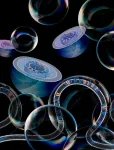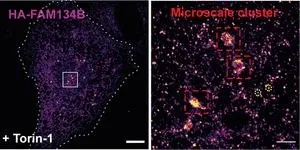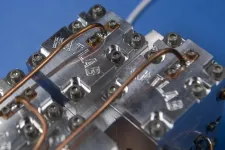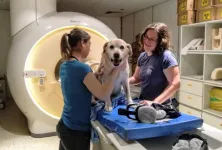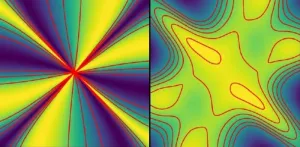(Press-News.org) FRANKFURT. A tangle of pockets, tubes and sac-like membrane structures runs through the cells of humans, animals, plants and fungi: the endoplasmic reticulum, or ER for short. In the ER, proteins are manufactured, folded into their three-dimensional structure and modified, lipids and hormones are produced and calcium concentrations in the cell are controlled. In addition, the ER forms the basis for the cellular transport system, feeds misfolded proteins to intracellular disposal and renders toxins that have entered the cell harmless.
In view of its multiple tasks, the ER is constantly being remodeled. A process called ER-phagy (roughly “self-digestion of the ER”) is responsible for ER degradation. Involved is a group of signal-receiving proteins – receptors – that are responsible for the membrane curvatures of the ER and thus for its multiple forms in the cell. In ER-phagy, the receptors accumulate at specific sites on the ER and increase membrane curvature to such an extent that, as a consequence, part of the ER is strangulated and broken down into its component parts by cellular recycling structures (autophagosomes).
In cell culture experiments, biochemical and molecular biological studies, and by computer simulations, the scientific team led by Professor Ivan Đikić of Goethe University Frankfurt first tested the membrane curvature receptor FAM134B and demonstrated that ubiquitin promotes and stabilizes the formation of clusters of FAM134B protein in the ER membrane. Thus, ubiquitin drives ER-phagy. Đikić explains: “Ubiquitin causes the FAM134B clusters to become more stable and the ER to bulge out more at these sites. The stronger membrane curvature then leads to further stabilization of the clusters and, moreover, attracts additional membrane curvature proteins. So the effect of ubiquitin is self-reinforcing.” The researchers were also able to detect cluster formation using super-high resolution microscopy.
Đikić continues: “To fulfill this function, ubiquitin changes the shape of part of the FAM134B protein. This is another facet of ubiquitin that performs an almost unbelievable array of tasks to keep all different cell functions working.”
The importance of ER-phagy is demonstrated by diseases resulting from a defective FAM134B protein. A team led by Professor Christian Hübner from Jena University Hospital previously identified mutations in the FAM134B gene causing a very rare hereditary sensory and autonomic neuropathy (HSAN), in which sensory nerves die. As a result, patients are unable to perceive pain and temperature correctly, which can lead to incorrect stresses or injuries going unnoticed and developing into chronic wounds. In a long-standing collaboration between Jena University Hospital and Goethe University Frankfurt FAM134B was identified as the first receptor for ER-phagy.
Mutations in another membrane curvature protein called ARL6IP1 cause a similar neurodegenerative disorder which combines sensory defects with muscle hardening (spasticity) in the legs. The scientific team led by Christian Hübner and Ivan Đikić has now identified that ARL6IP1 belongs to the ER-phagy machinery as well and is also ubiquitinated during ER-phagy.
Christian Hübner explains: “In mice that do not possess the ARL6IP1 protein, we can see that the ER virtually expands and degenerates as the cells age. This leads to an accumulation of misfolded proteins or protein clumps, which are no longer disposed of in the cell. As a result, nerve cells in particular, which do not renew as quickly as other body cells, die, causing the clinical symptoms in affected patients and genetically modified mice. We hypothesize from our data that the two membrane curvature receptors FAM134B and ARL6IP1 form mixed clusters during ER-phagy and depend on each other to control normal size and function of ER. Additional work will be required to fully acknowledge the role of ER-phagy in neurons as well as in other cell types.”
Overall, however, the research teams have taken a decisive step toward understanding ER-phagy, Đikić is convinced: “We now understand better how cells control their functions and thus create something we call cellular homeostasis. In biology, this knowledge allows fascinating insights into the incredible achievements of our cells, and for medicine it is essential for understanding diseases, diagnosing them on time and helping patients by developing new therapies.”
Scientists from the following institutions were involved in the work:
Goethe University Frankfurt, Germany
Jena University Hospital, Germany
Max Planck Institute for Biophysics, Frankfurt, Germany
Max Planck Institute of Biochemistry, Martinsried, Germany
Fraunhofer Institute for Translational Medicine and Pharmacology, Frankfurt, Germany
University Hospital RWTH Aachen, Germany
Howard Hughes Medical Institute, San Diego, La Jolla, Calif., USA
University of Groningen, The Netherlands
Aarhus University, Denmark
Publications:
1) Alexis González, Adriana Covarrubias-Pinto, Ramachandra M. Bhaskara, Marius Glogger, Santosh K. Kuncha, Audrey Xavier, Eric Seemann, Mohit Misra, Marina E. Hoffmann, Bastian Bräuning, Ashwin Balakrishnan, Britta Qualmann, Volker Dötsch, Brenda A. Schulman, Michael M. Kessels, Christian A. Hübner, Mike Heilemann, Gerhard Hummer, Ivan Dikic: Ubiquitination regulates ER-phagy and remodeling of endoplasmic reticulum. Nature (2023) https://doi.org/10.1038/s41586-023-06089-2
2) Hector Foronda, Yangxue Fu, Adriana Covarrubias-Pinto, Hartmut T. Bocker,
Alexis González, Eric Seemann, Patricia Franzka, Andrea Bock, Ramachandra M. Bhaskara, Lutz Liebmann, Marina E. Hoffmann, Istvan Katona, Nicole Koch, Joachim Weis, Ingo Kurth, Joseph G. Gleeson, Fulvio Reggiori, Gerhard Hummer, Michael M. Kessels, Britta Qualmann, Muriel Mari, Ivan Dikić, Christian A. Hübner: Heteromeric 1 clusters of ubiquitinated ER-shaping proteins drive ER-phagy. Nature (2023) https://doi.org/10.1038/s41586-023-06090-9
Background information:
EMTHERA research cluster: Emerging strategies against infections, inflammation, and impaired immune mechanisms https://www.emthera.de/
Collaborative Research Center (SFB 1177) "Molecular and functional characterization of selective autophagy".
http://www.sfb1177.de/
Frankfurt scientists discover new molecular mechanisms that eliminate intracellular damages – Mutations in this pathway trigger neurodegenerative diseases (2015)
https://www.goethe-university-frankfurt.de/74984432/Controller_in_the_Cell
Background information:
EMTHERA research cluster: Emerging strategies against infections, inflammation, and impaired immune mechanisms https://www.emthera.de/
Collaborative Research Center (SFB 1177) "Molecular and functional characterization of selective autophagy".
http://www.sfb1177.de/
Frankfurt scientists discover new molecular mechanisms that eliminate intracellular damages – Mutations in this pathway trigger neurodegenerative diseases (2015)
https://www.goethe-university-frankfurt.de/74984432/Controller_in_the_Cell
END
When the cell digests itself: How inherited neurodegenerative diseases develop
International research teams led by Goethe University Frankfurt and Jena University Hospital find mechanisms involved in regulation of structure and function of endoplasmic reticulum
2023-05-26
ELSE PRESS RELEASES FROM THIS DATE:
Army funds two quantum-related projects at Pitt
2023-05-26
The U.S. Army has awarded more than $5.7 million for two projects led by Michael Hatridge, associate professor of physics and astronomy in the Kenneth P. Dietrich School of Arts and Sciences. Both projects bring together a diverse group of researchers to overcome roadblocks in the field of quantum computing.
A four-year, $2.67 million grant is aimed at the next generation of modular quantum computing systems. Hatridge and co-principal investigators Robert Schoelkopf of Yale University have each developed unique ...
Emergence of solvated dielectrons observed for the first time
2023-05-26
Solvated dielectrons are the subject of many hypotheses among scientists, but have never been directly observed. They are described as a pair of electrons that is dissolved in liquids such as water or liquid ammonia. To make space for the electrons a cavity forms in the liquid, which the two electrons occupy. An international research team around Dr. Sebastian Hartweg, initially at Synchrotron SOLEIL (France), now at the Institute of Physics at the University of Freiburg and Prof. Dr. Ruth Signorell from ETH Zurich, including scientists ...
Networks in the dog brain
2023-05-26
A study on canine brain networks reveals that during mammalian brain evolution, the role of the cingulate cortex, a bilateral structure located deep in the cerebral cortex, was partly taken over by the lateral frontal lobes, which control problem-solving, task-switching, and goal-directed behavior. The study relies on a new canine resting state fMRI brain atlas, which can aid in the analysis of diseases characterized by dysfunctional integration and communication among brain areas.
Researchers interested in how dogs think can not only deduce it from their behavior, but they can also investigate their brain activity using fMRI (functional ...
Fractons as information storage: Not yet quite tangible, but close
2023-05-26
Excitations in solids can also be represented mathematically as quasiparticles; for example, lattice vibrations that increase with temperature can be well described as phonons. Mathematically, also quasiparticles can be described that have never been observed in a material before. If such "theoretical" quasiparticles have interesting talents, then it is worth taking a closer look. Take fractons, for example.
Perfect storage of information
Fractons are fractions of spin excitations and are not allowed to possess kinetic energy. As a consequence, they are completely stationary and immobile. This makes fractons new candidates for perfectly secure information storage. Especially since ...
Defence lawyers face challenges accessing and reviewing digital evidence, study shows
2023-05-26
Defence lawyers face numerous challenges accessing and reviewing evidence from phones and computers, a new study shows.
Solicitors and barristers have reported their use of digital evidence can be restricted by limited or late access, large volumes of material, and tight turnaround times to secure legal aid funding and choose and instruct independent experts.
The research calls for more clarity and transparency around the collection and analysis of digital evidence and the streamlining of the format and presentation of information.
The current volume and diversity of digital evidence available escalates tensions, delays access to digital ...
Barren habitat for sows leaves imprint on piglets’ brains
2023-05-26
In a new study, researchers from Uppsala University in Sweden, together with colleagues from the University of São Paulo, Brazil, have investigated the impact that a barren living environment for sows leaves on the next generation. The pigs in the study were bred in Brazil and kept according to breeding standards in that country. The sows’ uncomfortable and unstimulating environment brought with it several different types of changes in the epigenome of their offspring.
In many parts of the world, sows are kept confined in concrete stalls while they are pregnant. This is a bad environment for the pigs, both in terms ...
Quantum sensor for a future navigation system tested aboard Royal Navy ship
2023-05-26
A prototype quantum sensor with potential applications in GPS-free navigation, developed at Imperial College London, has been tested in collaboration with the Royal Navy.
The test marks an important step in bringing new quantum technologies out of the lab and into real-world settings.
Many navigation systems today rely on global navigation satellite systems (GNSS), such as GPS, which uses signals from satellites orbiting the Earth. However, GPS navigation is not always accessible, obstacles like tall buildings can easily block the satellite signals, and they are also susceptible ...
Hydrogen sulfide in cancer treatment
2023-05-26
Hydrogen sulfide is usually a highly toxic gas. However, with careful preparation, it can be used to support photothermal therapy (PTT) in treating cancer, as a team of researchers reporting in the journal Angewandte Chemie has recently discovered. As the team reports, an adjuvant releasing hydrogen sulfide causes tumor cells to lose their natural heat protection and thus to become significantly more sensitive to PTT.
Breathing in gaseous hydrogen sulfide usually causes us to suffocate, because the gas suppresses the respiratory chain in the mitochondria, ...
First death in the UK associated with Xylazine
2023-05-26
The death of a 43-year-old male is the first in the UK to be associated with Xylazine and marks the entry of the drug into the UK drug supply.
New research published in the Journal of Forensic and Legal Medicine from King’s College London details the death of the man in May 2022 from the effects of Xylazine alongside heroin, fentanyl and cocaine.
Xylazine is a non-opioid sedative, painkiller and muscle relaxant used in veterinary medicine as a tranquiliser for large animals. The drug – known ...
Developing a blueprint for mobile data visualisation
2023-05-26
By Jovina Ang
SMU Office of Research – It is predicted that by 2025, almost three quarters of the internet users in the world will be mobile-only users.
While mobile devices provide ready access to data, there are limitations to how the data can be optimally presented due to the small form factor and limited screen size.
For example, it is a lot easier to show 10,000 data points on a desktop compared to a smartphone, which typically has a screen size of 2.82 inches (71.5 mm) ...
LAST 30 PRESS RELEASES:
Optimized biochar use could cut China’s cropland nitrous oxide emissions by up to half
Neural progesterone receptors link ovulation and sexual receptivity in medaka
A new Japanese study investigates how tariff policies influence long-run economic growth
Mental trauma succeeds 1 in 7 dog related injuries, claims data suggest
Breastfeeding may lower mums’ later life depression/anxiety risks for up to 10 years after pregnancy
Study finds more than a quarter of adults worldwide could benefit from GLP-1 medications for weight loss
Hobbies don’t just improve personal lives, they can boost workplace creativity too
Study shows federal safety metric inappropriately penalizes hospitals for lifesaving stroke procedures
Improving sleep isn’t enough: researchers highlight daytime function as key to assessing insomnia treatments
Rice Brain Institute awards first seed grants to jump-start collaborative brain health research
Personalizing cancer treatments significantly improve outcome success
UW researchers analyzed which anthologized writers and books get checked out the most from Seattle Public Library
Study finds food waste compost less effective than potting mix alone
UCLA receives $7.3 million for wide-ranging cannabis research
Why this little-known birth control option deserves more attention
Johns Hopkins-led team creates first map of nerve circuitry in bone, identifies key signals for bone repair
UC Irvine astronomers spot largest known stream of super-heated gas in the universe
Research shows how immune system reacts to pig kidney transplants in living patients
Dark stars could help solve three pressing puzzles of the high-redshift universe
Manganese gets its moment as a potential fuel cell catalyst
“Gifted word learner” dogs can pick up new words by overhearing their owners’ talk
More data, more sharing can help avoid misinterpreting “smoking gun” signals in topological physics
An illegal fentanyl supply shock may have contributed to a dramatic decline in deaths
Some dogs can learn new words by eavesdropping on their owners
Scientists trace facial gestures back to their source. before a smile appears, the brain has already decided
Is “Smoking Gun” evidence enough to prove scientific discovery?
Scientists find microbes enhance the benefits of trees by removing greenhouse gases
KAIST-Yonsei team identifies origin cells for malignant brain tumor common in young adults
Team discovers unexpected oscillation states in magnetic vortices
How the brain creates facial expressions
[Press-News.org] When the cell digests itself: How inherited neurodegenerative diseases developInternational research teams led by Goethe University Frankfurt and Jena University Hospital find mechanisms involved in regulation of structure and function of endoplasmic reticulum
